University Assignment: Pathophysiology and Pharmacology Homework
VerifiedAdded on 2023/01/20
|7
|1524
|1
Homework Assignment
AI Summary
This assignment delves into the core concepts of pathophysiology and pharmacology, addressing key questions about cholesterol, lipoproteins, and drug interactions. The solution begins with a definition of cholesterol and its importance, followed by an explanation of its transport mechanisms in the blood and the role of lipoproteins. The assignment then explores the liver's synthesis processes, specifically focusing on VLDL and LDL particles, including their creation and functions. Furthermore, the solution examines lipid-lowering drugs, such as atorvastatin, discussing their mechanism of action and the role of HMG-CoA reductase. The assignment concludes by analyzing the interaction between grapefruit juice and medications, detailing the consequences of this interaction on drug bioavailability and adverse effects, particularly concerning statin drugs. The references used are also listed.
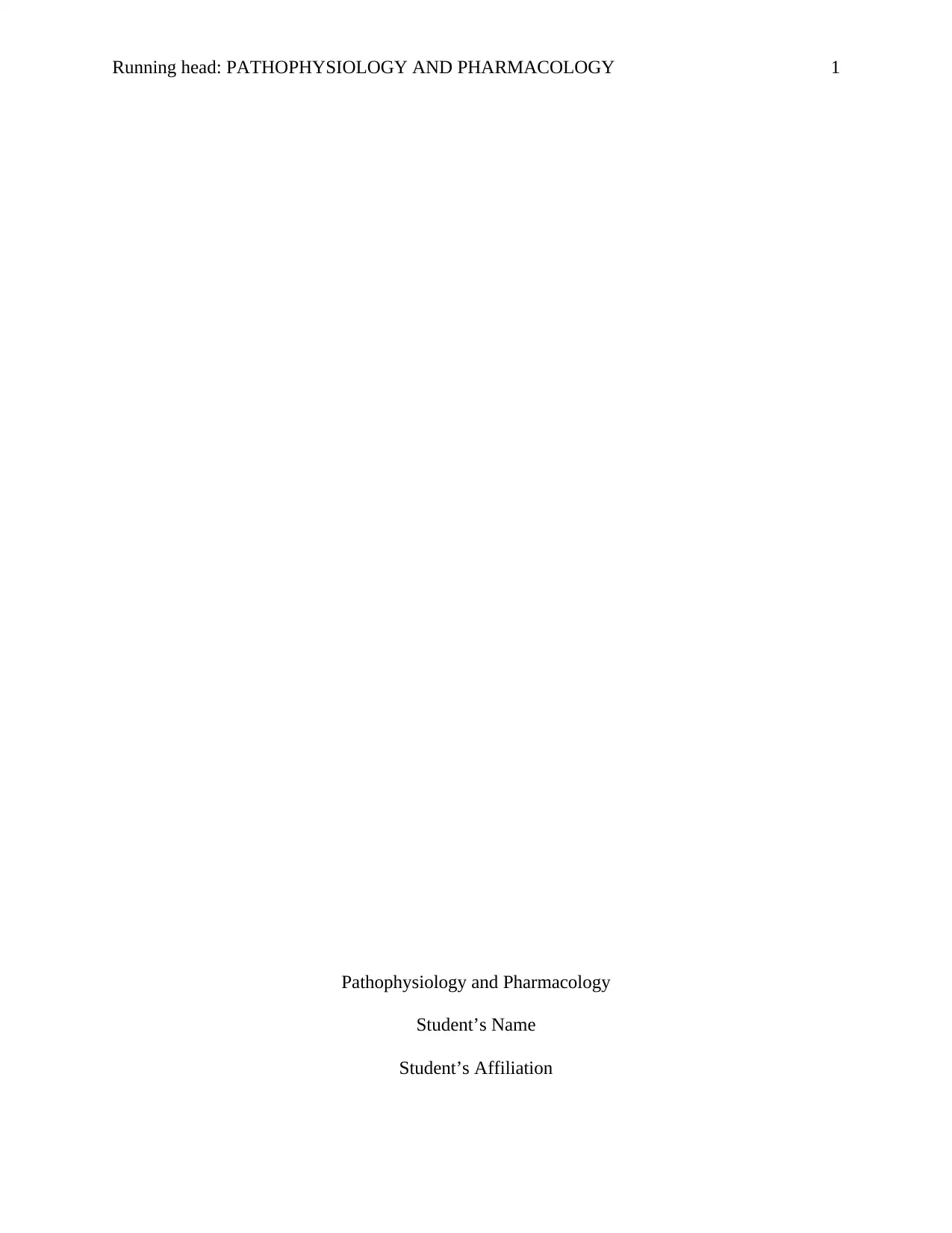
Running head: PATHOPHYSIOLOGY AND PHARMACOLOGY 1
Pathophysiology and Pharmacology
Student’s Name
Student’s Affiliation
Pathophysiology and Pharmacology
Student’s Name
Student’s Affiliation
Paraphrase This Document
Need a fresh take? Get an instant paraphrase of this document with our AI Paraphraser

PATHOPHYSIOLOGY AND PHARMACOLOGY 2
1.
a) What is cholesterol and why is it important?
Cholesterol is a steroid alcohol; it is an organic molecule with unsaturated alcohol and
steroid. The lipid, cholesterol, is found in all animal cells as it is a vital component of the cell
membrane; hence its importance it maintaining the integrity of cells (Feingold & Grunfeld,
2019). Also, cholesterol regulates membrane fluidity with respect to temperature changes. It is
serves a precursor in the biosynthesis of crucial substances such as bile acids, steroid hormones,
and vitamin D (Feingold & Grunfeld, 2019).
b) How is cholesterol transported in the blood?
Cholesterol is nonpolar in nature. It minimally dissolves in hydrophilic media, such as blood
or water. Therefore, it needs to be associated with lipoproteins for easy transportation in blood.
Lipoproteins are spherical assemblies that contain lipids and proteins; the outer parts are water-
soluble while the inward regions are lipid-soluble hence, its efficiency in cholesterol
transportation in blood (Feingold & Grunfeld, 2019). Plasma lipoproteins vary with density,
electrophoretic mobility, size, and the cholesterol content. As a result, the low density
lipoproteins (LDH) are favorable in transporting cholesterol from liver cells to other body parts
in blood.
c) What is a lipoprotein
A lipoprotein is a lipid-protein biochemical complex whose principal role is transporting
cholesterol in blood. They are globular in shape. Phospholipids, apoproteins, and unesterified
cholesterol enclose a nonpolar core lipid that comprises of esterified cholesterol and triglycerides
(TAGs) (Feingold & Grunfeld, 2019).
2.
1.
a) What is cholesterol and why is it important?
Cholesterol is a steroid alcohol; it is an organic molecule with unsaturated alcohol and
steroid. The lipid, cholesterol, is found in all animal cells as it is a vital component of the cell
membrane; hence its importance it maintaining the integrity of cells (Feingold & Grunfeld,
2019). Also, cholesterol regulates membrane fluidity with respect to temperature changes. It is
serves a precursor in the biosynthesis of crucial substances such as bile acids, steroid hormones,
and vitamin D (Feingold & Grunfeld, 2019).
b) How is cholesterol transported in the blood?
Cholesterol is nonpolar in nature. It minimally dissolves in hydrophilic media, such as blood
or water. Therefore, it needs to be associated with lipoproteins for easy transportation in blood.
Lipoproteins are spherical assemblies that contain lipids and proteins; the outer parts are water-
soluble while the inward regions are lipid-soluble hence, its efficiency in cholesterol
transportation in blood (Feingold & Grunfeld, 2019). Plasma lipoproteins vary with density,
electrophoretic mobility, size, and the cholesterol content. As a result, the low density
lipoproteins (LDH) are favorable in transporting cholesterol from liver cells to other body parts
in blood.
c) What is a lipoprotein
A lipoprotein is a lipid-protein biochemical complex whose principal role is transporting
cholesterol in blood. They are globular in shape. Phospholipids, apoproteins, and unesterified
cholesterol enclose a nonpolar core lipid that comprises of esterified cholesterol and triglycerides
(TAGs) (Feingold & Grunfeld, 2019).
2.
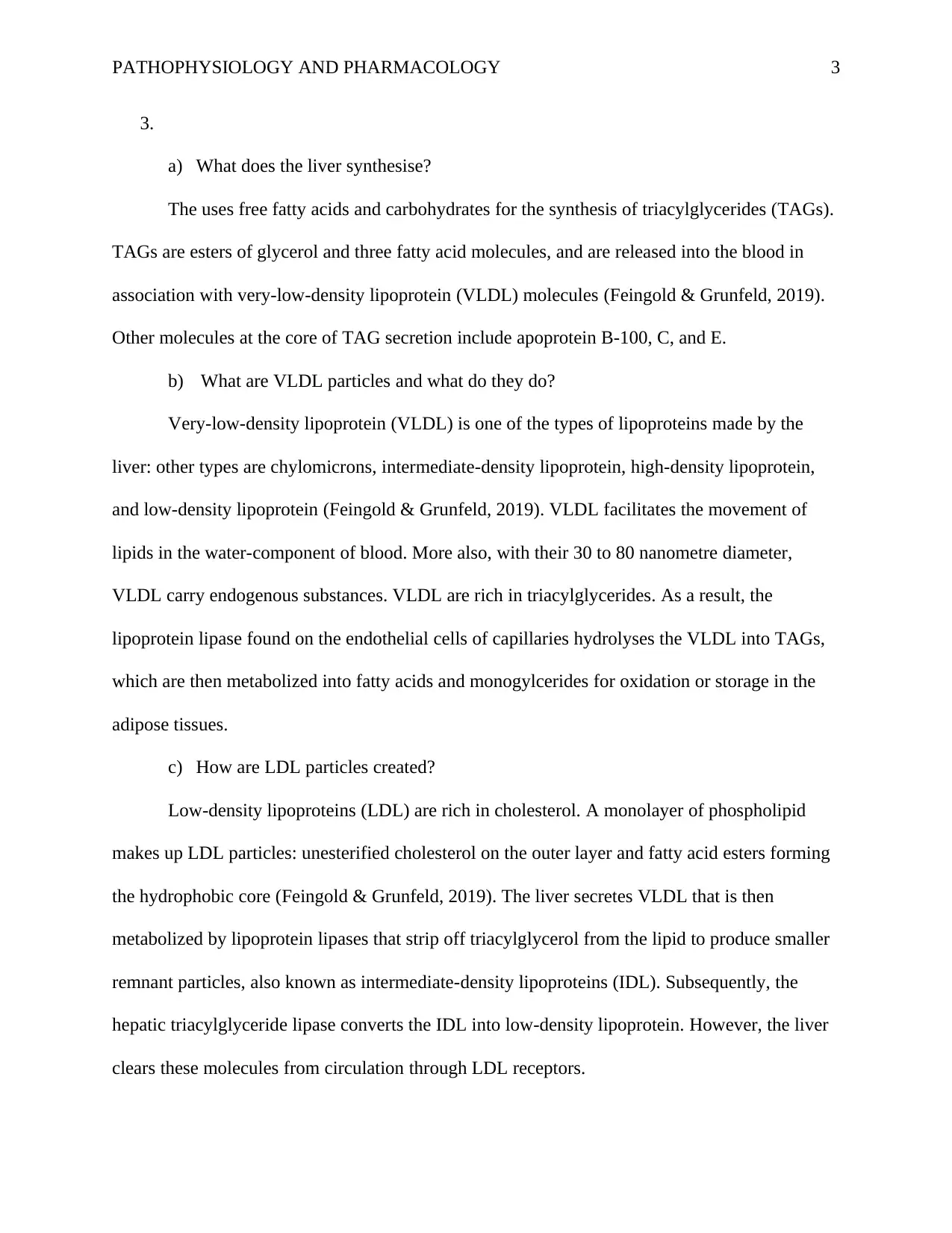
PATHOPHYSIOLOGY AND PHARMACOLOGY 3
3.
a) What does the liver synthesise?
The uses free fatty acids and carbohydrates for the synthesis of triacylglycerides (TAGs).
TAGs are esters of glycerol and three fatty acid molecules, and are released into the blood in
association with very-low-density lipoprotein (VLDL) molecules (Feingold & Grunfeld, 2019).
Other molecules at the core of TAG secretion include apoprotein B-100, C, and E.
b) What are VLDL particles and what do they do?
Very-low-density lipoprotein (VLDL) is one of the types of lipoproteins made by the
liver: other types are chylomicrons, intermediate-density lipoprotein, high-density lipoprotein,
and low-density lipoprotein (Feingold & Grunfeld, 2019). VLDL facilitates the movement of
lipids in the water-component of blood. More also, with their 30 to 80 nanometre diameter,
VLDL carry endogenous substances. VLDL are rich in triacylglycerides. As a result, the
lipoprotein lipase found on the endothelial cells of capillaries hydrolyses the VLDL into TAGs,
which are then metabolized into fatty acids and monogylcerides for oxidation or storage in the
adipose tissues.
c) How are LDL particles created?
Low-density lipoproteins (LDL) are rich in cholesterol. A monolayer of phospholipid
makes up LDL particles: unesterified cholesterol on the outer layer and fatty acid esters forming
the hydrophobic core (Feingold & Grunfeld, 2019). The liver secretes VLDL that is then
metabolized by lipoprotein lipases that strip off triacylglycerol from the lipid to produce smaller
remnant particles, also known as intermediate-density lipoproteins (IDL). Subsequently, the
hepatic triacylglyceride lipase converts the IDL into low-density lipoprotein. However, the liver
clears these molecules from circulation through LDL receptors.
3.
a) What does the liver synthesise?
The uses free fatty acids and carbohydrates for the synthesis of triacylglycerides (TAGs).
TAGs are esters of glycerol and three fatty acid molecules, and are released into the blood in
association with very-low-density lipoprotein (VLDL) molecules (Feingold & Grunfeld, 2019).
Other molecules at the core of TAG secretion include apoprotein B-100, C, and E.
b) What are VLDL particles and what do they do?
Very-low-density lipoprotein (VLDL) is one of the types of lipoproteins made by the
liver: other types are chylomicrons, intermediate-density lipoprotein, high-density lipoprotein,
and low-density lipoprotein (Feingold & Grunfeld, 2019). VLDL facilitates the movement of
lipids in the water-component of blood. More also, with their 30 to 80 nanometre diameter,
VLDL carry endogenous substances. VLDL are rich in triacylglycerides. As a result, the
lipoprotein lipase found on the endothelial cells of capillaries hydrolyses the VLDL into TAGs,
which are then metabolized into fatty acids and monogylcerides for oxidation or storage in the
adipose tissues.
c) How are LDL particles created?
Low-density lipoproteins (LDL) are rich in cholesterol. A monolayer of phospholipid
makes up LDL particles: unesterified cholesterol on the outer layer and fatty acid esters forming
the hydrophobic core (Feingold & Grunfeld, 2019). The liver secretes VLDL that is then
metabolized by lipoprotein lipases that strip off triacylglycerol from the lipid to produce smaller
remnant particles, also known as intermediate-density lipoproteins (IDL). Subsequently, the
hepatic triacylglyceride lipase converts the IDL into low-density lipoprotein. However, the liver
clears these molecules from circulation through LDL receptors.
⊘ This is a preview!⊘
Do you want full access?
Subscribe today to unlock all pages.

Trusted by 1+ million students worldwide
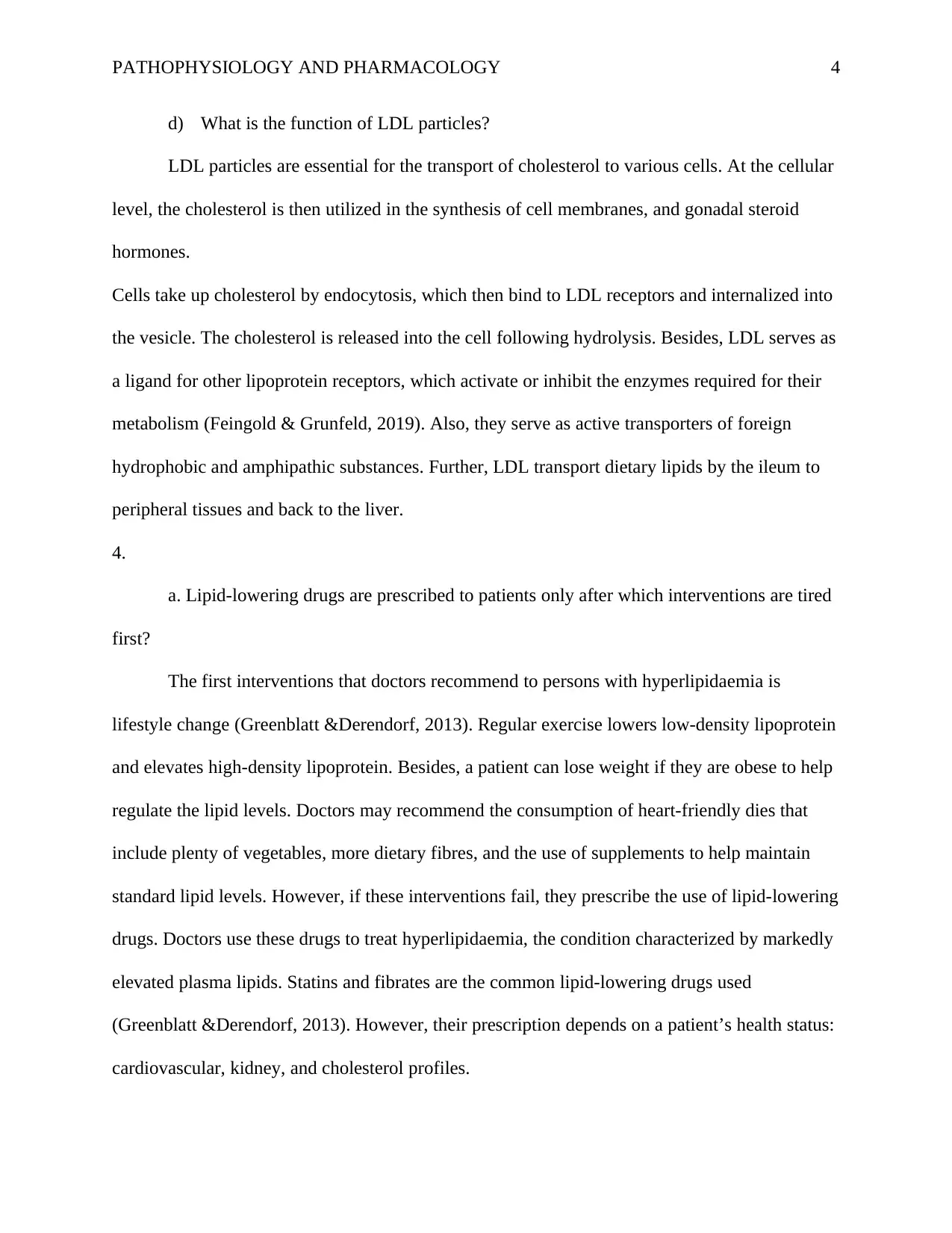
PATHOPHYSIOLOGY AND PHARMACOLOGY 4
d) What is the function of LDL particles?
LDL particles are essential for the transport of cholesterol to various cells. At the cellular
level, the cholesterol is then utilized in the synthesis of cell membranes, and gonadal steroid
hormones.
Cells take up cholesterol by endocytosis, which then bind to LDL receptors and internalized into
the vesicle. The cholesterol is released into the cell following hydrolysis. Besides, LDL serves as
a ligand for other lipoprotein receptors, which activate or inhibit the enzymes required for their
metabolism (Feingold & Grunfeld, 2019). Also, they serve as active transporters of foreign
hydrophobic and amphipathic substances. Further, LDL transport dietary lipids by the ileum to
peripheral tissues and back to the liver.
4.
a. Lipid-lowering drugs are prescribed to patients only after which interventions are tired
first?
The first interventions that doctors recommend to persons with hyperlipidaemia is
lifestyle change (Greenblatt &Derendorf, 2013). Regular exercise lowers low-density lipoprotein
and elevates high-density lipoprotein. Besides, a patient can lose weight if they are obese to help
regulate the lipid levels. Doctors may recommend the consumption of heart-friendly dies that
include plenty of vegetables, more dietary fibres, and the use of supplements to help maintain
standard lipid levels. However, if these interventions fail, they prescribe the use of lipid-lowering
drugs. Doctors use these drugs to treat hyperlipidaemia, the condition characterized by markedly
elevated plasma lipids. Statins and fibrates are the common lipid-lowering drugs used
(Greenblatt &Derendorf, 2013). However, their prescription depends on a patient’s health status:
cardiovascular, kidney, and cholesterol profiles.
d) What is the function of LDL particles?
LDL particles are essential for the transport of cholesterol to various cells. At the cellular
level, the cholesterol is then utilized in the synthesis of cell membranes, and gonadal steroid
hormones.
Cells take up cholesterol by endocytosis, which then bind to LDL receptors and internalized into
the vesicle. The cholesterol is released into the cell following hydrolysis. Besides, LDL serves as
a ligand for other lipoprotein receptors, which activate or inhibit the enzymes required for their
metabolism (Feingold & Grunfeld, 2019). Also, they serve as active transporters of foreign
hydrophobic and amphipathic substances. Further, LDL transport dietary lipids by the ileum to
peripheral tissues and back to the liver.
4.
a. Lipid-lowering drugs are prescribed to patients only after which interventions are tired
first?
The first interventions that doctors recommend to persons with hyperlipidaemia is
lifestyle change (Greenblatt &Derendorf, 2013). Regular exercise lowers low-density lipoprotein
and elevates high-density lipoprotein. Besides, a patient can lose weight if they are obese to help
regulate the lipid levels. Doctors may recommend the consumption of heart-friendly dies that
include plenty of vegetables, more dietary fibres, and the use of supplements to help maintain
standard lipid levels. However, if these interventions fail, they prescribe the use of lipid-lowering
drugs. Doctors use these drugs to treat hyperlipidaemia, the condition characterized by markedly
elevated plasma lipids. Statins and fibrates are the common lipid-lowering drugs used
(Greenblatt &Derendorf, 2013). However, their prescription depends on a patient’s health status:
cardiovascular, kidney, and cholesterol profiles.
Paraphrase This Document
Need a fresh take? Get an instant paraphrase of this document with our AI Paraphraser
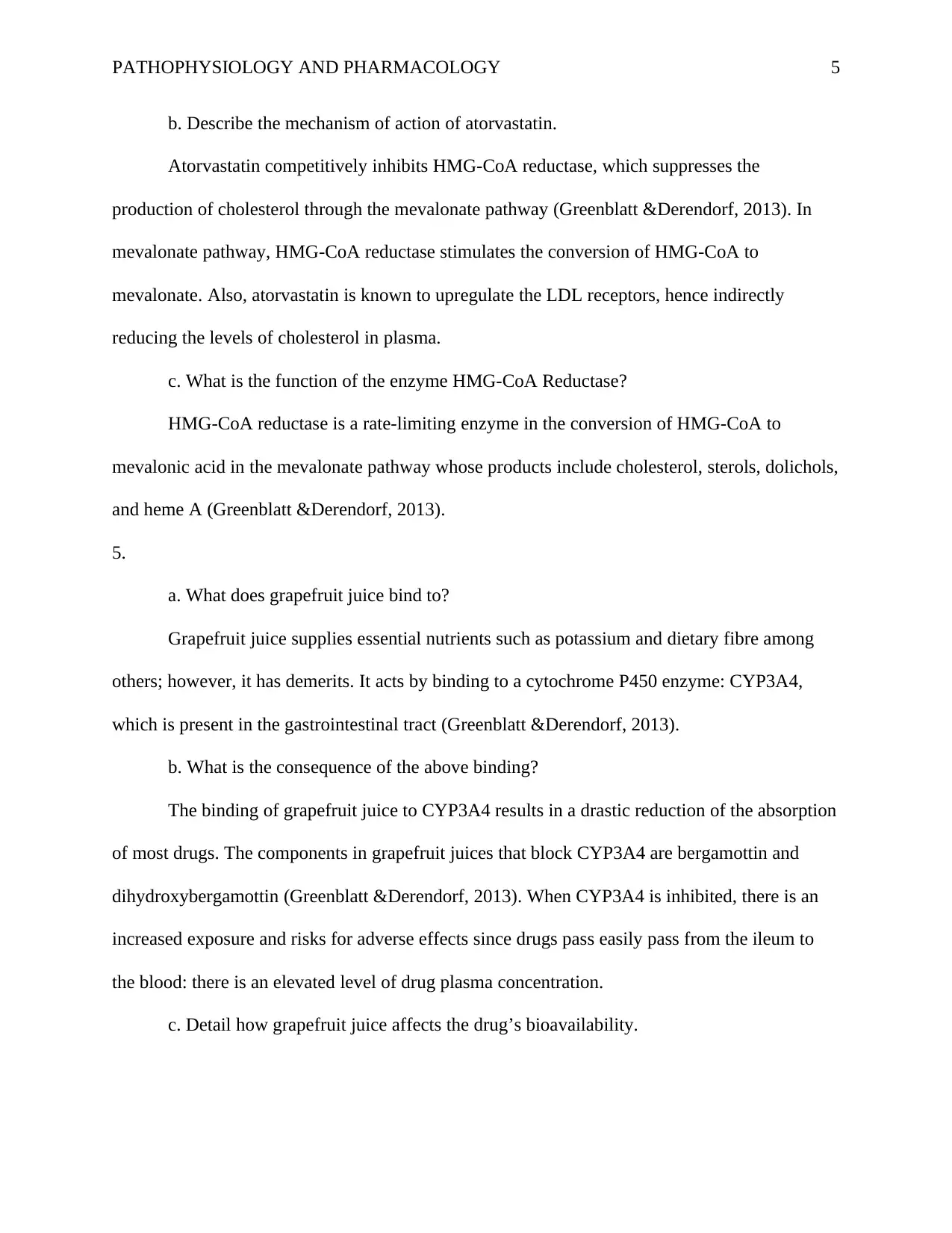
PATHOPHYSIOLOGY AND PHARMACOLOGY 5
b. Describe the mechanism of action of atorvastatin.
Atorvastatin competitively inhibits HMG-CoA reductase, which suppresses the
production of cholesterol through the mevalonate pathway (Greenblatt &Derendorf, 2013). In
mevalonate pathway, HMG-CoA reductase stimulates the conversion of HMG-CoA to
mevalonate. Also, atorvastatin is known to upregulate the LDL receptors, hence indirectly
reducing the levels of cholesterol in plasma.
c. What is the function of the enzyme HMG-CoA Reductase?
HMG-CoA reductase is a rate-limiting enzyme in the conversion of HMG-CoA to
mevalonic acid in the mevalonate pathway whose products include cholesterol, sterols, dolichols,
and heme A (Greenblatt &Derendorf, 2013).
5.
a. What does grapefruit juice bind to?
Grapefruit juice supplies essential nutrients such as potassium and dietary fibre among
others; however, it has demerits. It acts by binding to a cytochrome P450 enzyme: CYP3A4,
which is present in the gastrointestinal tract (Greenblatt &Derendorf, 2013).
b. What is the consequence of the above binding?
The binding of grapefruit juice to CYP3A4 results in a drastic reduction of the absorption
of most drugs. The components in grapefruit juices that block CYP3A4 are bergamottin and
dihydroxybergamottin (Greenblatt &Derendorf, 2013). When CYP3A4 is inhibited, there is an
increased exposure and risks for adverse effects since drugs pass easily pass from the ileum to
the blood: there is an elevated level of drug plasma concentration.
c. Detail how grapefruit juice affects the drug’s bioavailability.
b. Describe the mechanism of action of atorvastatin.
Atorvastatin competitively inhibits HMG-CoA reductase, which suppresses the
production of cholesterol through the mevalonate pathway (Greenblatt &Derendorf, 2013). In
mevalonate pathway, HMG-CoA reductase stimulates the conversion of HMG-CoA to
mevalonate. Also, atorvastatin is known to upregulate the LDL receptors, hence indirectly
reducing the levels of cholesterol in plasma.
c. What is the function of the enzyme HMG-CoA Reductase?
HMG-CoA reductase is a rate-limiting enzyme in the conversion of HMG-CoA to
mevalonic acid in the mevalonate pathway whose products include cholesterol, sterols, dolichols,
and heme A (Greenblatt &Derendorf, 2013).
5.
a. What does grapefruit juice bind to?
Grapefruit juice supplies essential nutrients such as potassium and dietary fibre among
others; however, it has demerits. It acts by binding to a cytochrome P450 enzyme: CYP3A4,
which is present in the gastrointestinal tract (Greenblatt &Derendorf, 2013).
b. What is the consequence of the above binding?
The binding of grapefruit juice to CYP3A4 results in a drastic reduction of the absorption
of most drugs. The components in grapefruit juices that block CYP3A4 are bergamottin and
dihydroxybergamottin (Greenblatt &Derendorf, 2013). When CYP3A4 is inhibited, there is an
increased exposure and risks for adverse effects since drugs pass easily pass from the ileum to
the blood: there is an elevated level of drug plasma concentration.
c. Detail how grapefruit juice affects the drug’s bioavailability.
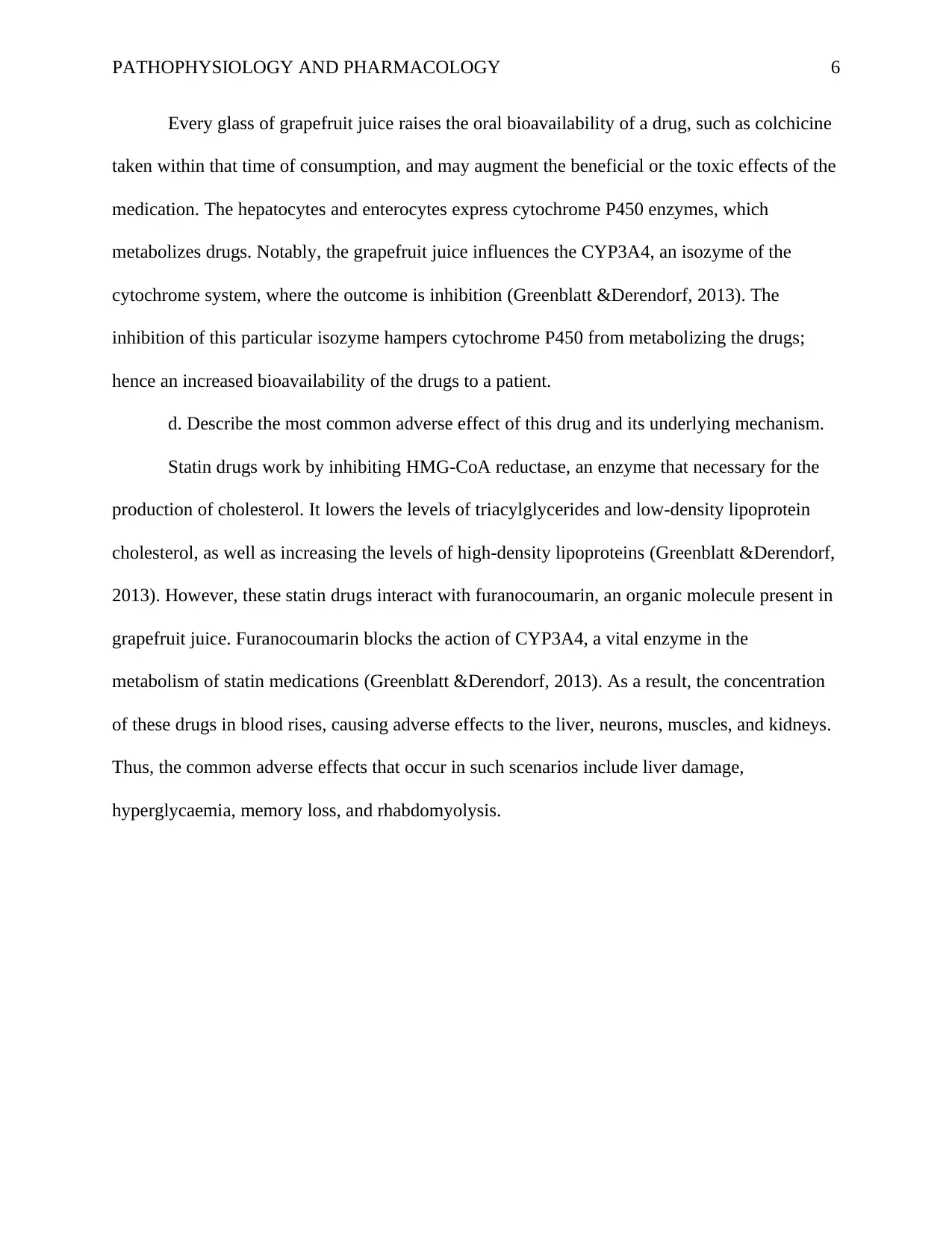
PATHOPHYSIOLOGY AND PHARMACOLOGY 6
Every glass of grapefruit juice raises the oral bioavailability of a drug, such as colchicine
taken within that time of consumption, and may augment the beneficial or the toxic effects of the
medication. The hepatocytes and enterocytes express cytochrome P450 enzymes, which
metabolizes drugs. Notably, the grapefruit juice influences the CYP3A4, an isozyme of the
cytochrome system, where the outcome is inhibition (Greenblatt &Derendorf, 2013). The
inhibition of this particular isozyme hampers cytochrome P450 from metabolizing the drugs;
hence an increased bioavailability of the drugs to a patient.
d. Describe the most common adverse effect of this drug and its underlying mechanism.
Statin drugs work by inhibiting HMG-CoA reductase, an enzyme that necessary for the
production of cholesterol. It lowers the levels of triacylglycerides and low-density lipoprotein
cholesterol, as well as increasing the levels of high-density lipoproteins (Greenblatt &Derendorf,
2013). However, these statin drugs interact with furanocoumarin, an organic molecule present in
grapefruit juice. Furanocoumarin blocks the action of CYP3A4, a vital enzyme in the
metabolism of statin medications (Greenblatt &Derendorf, 2013). As a result, the concentration
of these drugs in blood rises, causing adverse effects to the liver, neurons, muscles, and kidneys.
Thus, the common adverse effects that occur in such scenarios include liver damage,
hyperglycaemia, memory loss, and rhabdomyolysis.
Every glass of grapefruit juice raises the oral bioavailability of a drug, such as colchicine
taken within that time of consumption, and may augment the beneficial or the toxic effects of the
medication. The hepatocytes and enterocytes express cytochrome P450 enzymes, which
metabolizes drugs. Notably, the grapefruit juice influences the CYP3A4, an isozyme of the
cytochrome system, where the outcome is inhibition (Greenblatt &Derendorf, 2013). The
inhibition of this particular isozyme hampers cytochrome P450 from metabolizing the drugs;
hence an increased bioavailability of the drugs to a patient.
d. Describe the most common adverse effect of this drug and its underlying mechanism.
Statin drugs work by inhibiting HMG-CoA reductase, an enzyme that necessary for the
production of cholesterol. It lowers the levels of triacylglycerides and low-density lipoprotein
cholesterol, as well as increasing the levels of high-density lipoproteins (Greenblatt &Derendorf,
2013). However, these statin drugs interact with furanocoumarin, an organic molecule present in
grapefruit juice. Furanocoumarin blocks the action of CYP3A4, a vital enzyme in the
metabolism of statin medications (Greenblatt &Derendorf, 2013). As a result, the concentration
of these drugs in blood rises, causing adverse effects to the liver, neurons, muscles, and kidneys.
Thus, the common adverse effects that occur in such scenarios include liver damage,
hyperglycaemia, memory loss, and rhabdomyolysis.
⊘ This is a preview!⊘
Do you want full access?
Subscribe today to unlock all pages.

Trusted by 1+ million students worldwide
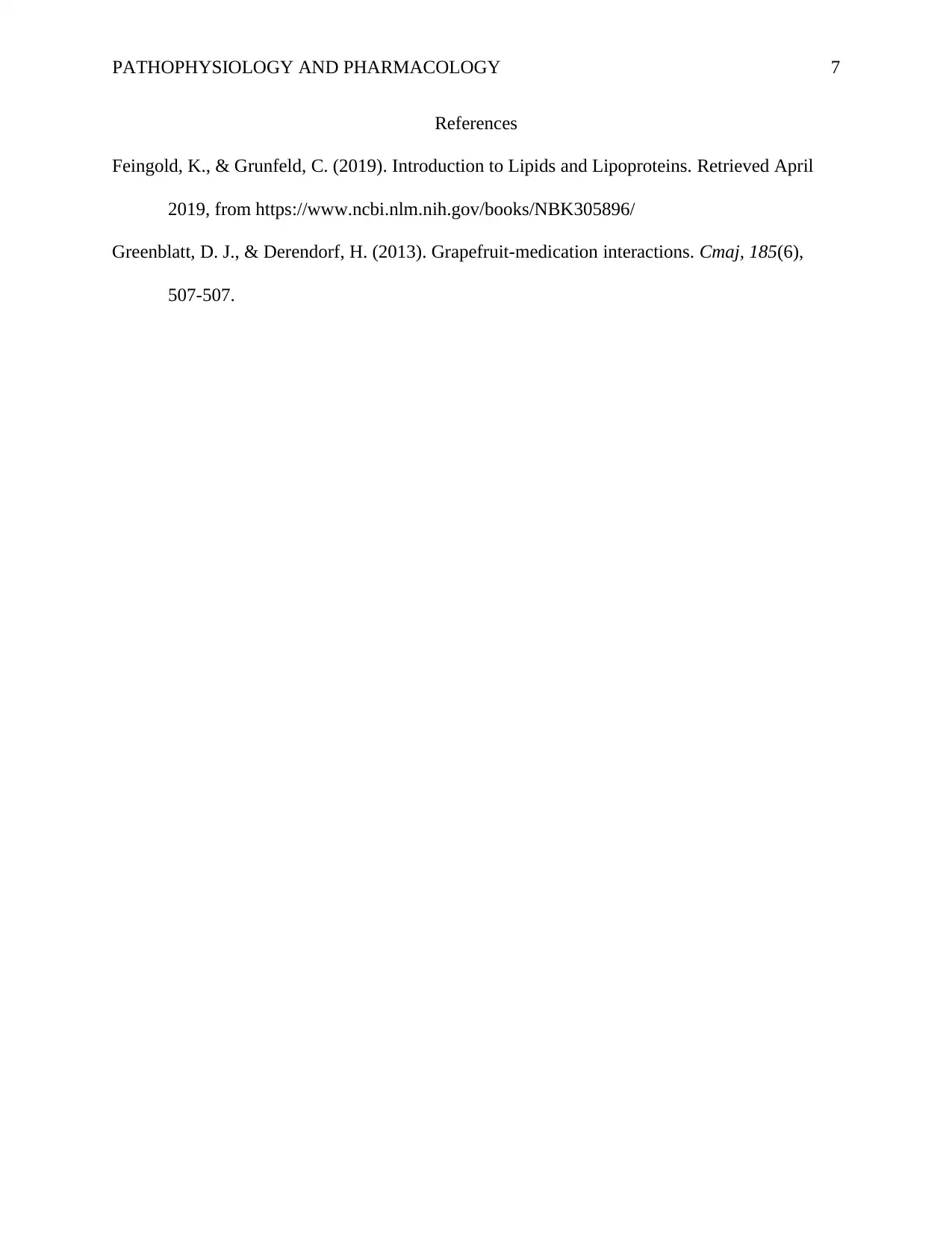
PATHOPHYSIOLOGY AND PHARMACOLOGY 7
References
Feingold, K., & Grunfeld, C. (2019). Introduction to Lipids and Lipoproteins. Retrieved April
2019, from https://www.ncbi.nlm.nih.gov/books/NBK305896/
Greenblatt, D. J., & Derendorf, H. (2013). Grapefruit-medication interactions. Cmaj, 185(6),
507-507.
References
Feingold, K., & Grunfeld, C. (2019). Introduction to Lipids and Lipoproteins. Retrieved April
2019, from https://www.ncbi.nlm.nih.gov/books/NBK305896/
Greenblatt, D. J., & Derendorf, H. (2013). Grapefruit-medication interactions. Cmaj, 185(6),
507-507.
1 out of 7
Your All-in-One AI-Powered Toolkit for Academic Success.
+13062052269
info@desklib.com
Available 24*7 on WhatsApp / Email
![[object Object]](/_next/static/media/star-bottom.7253800d.svg)
Unlock your academic potential
Copyright © 2020–2026 A2Z Services. All Rights Reserved. Developed and managed by ZUCOL.


